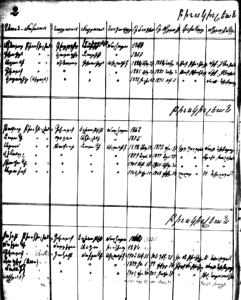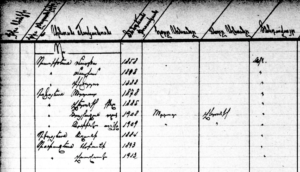This article is part of a continuing series documenting the available records for research into one’s Armenian family roots. Part I in the series supplied a historical background on the Armenian genealogy movement as well as specific records available for Syria. In Part 2, records from Lebanon and Israel were detailed.
Greece
Alongside Syria and Lebanon, Greece offers some of the most important post-Genocide records for Armenians. (Of course, there are also pre-Genocide records, as well.) Fortunately, a significant amount of the church records were microfilmed by the Mormon church and are contained in the Latter Day Saints (LDS) Family History Library.
Each church in various communities has its own register. In addition, the Prelacy in Athens compiled a register combining records from each of the parishes. Thus, it is important to check both sources to verify information, to identify potential discrepancies as well as additional information in one or the other source. Typically, the individual parish records are more complete, encompassing a longer span of time.
The oldest records available are for St. Hovhannes Garabed Church of Crete. The baptisms date from 1700, marriages from 1823, and funerals from 1669. Unfortunately, they are very difficult to read.

There is a fair amount of additional information available beyond the typical sacraments recorded by each church. For example, there are extensive documents related to the repatriation of Armenians to Soviet Armenia following World War II. There are similar records in Armenia documenting the arrival of the repatriates. Thus, another opportunity exists for comparison and validation of information.
St. Asdvadzadzin Armenian Apostolic Church of Thessaloniki offers another interesting example as the records begin in 1885. The register begins with a household census for 35 families followed by the listing of sacraments. An example may help to illustrate just how far one can trace their roots, should they be fortunate enough to have families from these locations.

There were three Piusgiulian households, each headed by a son of Kevork and Yeghisapet: Medzadour (born 1847), Takvor (born 1862), and Hagop (born 1864). The records indicate that the sons were all born in Malgara (Rodosto region of Thrace). While Medzadour and Takvor were most likely married in Malgara, Hagop was married to Makrouhi Malkhasian on Nov. 27, 1894 in Thessaloniki. On this record, Hagop’s father is listed as Kevork Minas Piusgiulian. Thus, taking us one more generation back in the assumption that Kevork’s father was named Minas.
It is simple, then, to confirm the information of the children of the three brothers, all having been born in Thessaloniki, and also, to find their marriages. For example, Kevork (age 28), the son of Medzadour, married Haygouhi Toukhmanian (age 18, born Chmshgadzak) on July 8, 1912. The baptism record for Kevork indicates he was born on Sep. 27, 1885 and baptized Oct. 4, 1885, thus making him actually 27 when married.
From the records, we can see other Piusgiulian’s from Malgara moved to Thessaloniki. Two sons of Haroutiun Piusgiulian, Vahan and Yervant, were also married around the same time as Kevork and had been born in Malgara. An almost 100-year history of this one family can be discerned from the available sources.
It will be of special interest to many that a number of refugee censuses were conducted in Greece, as well. The information is generally very limited (i.e. name of the individual, father’s name, age, birthplace, occupation, number of people in the family, etc…). Unfortunately, the censuses are generally not in any sort of order. Thus, their usage will be limited until such time as the records are entered into a searchable database. One aspect I find fascinating is the inclusion of individual photographs in certain cases. The recording of refugees continued for many years.
One refugee list, dated Dec. 18, 1924, included the Tatarian family of Gesaria: father, Artin; mother, Filor; and sons, Apraham and Hagop. Hagop was stated to be nine years old, born in 1915. I was able to locate the baptism record for Hagop from St. Krikor Lusavorich Church. It confirms the parents’ names as Haroutiun Tatarian and Filor Chapoutian. Hagop was born on Oct. 2, 1914 and baptized on Nov. 29, 1914. It is satisfying to be able to verify information in this way.
Another refugee census seems to have been taken for those that were part of the 1923 population exchange between Greece and Turkey. The two locales included were Adana and Agn. 48 people were listed from Agn including the Tshkhoyian family – father Drtad (born 1878 Agn), mother Veronig (born 1885 Agn), son Haygazoun (born 1908 Agn), and daughter Arpine (born 1909 Agn). They were living in the Pangrati neighborhood of Athens. On Aug. 1, 1923, this family arrived at the port of New York on the SS Constantinople. They were joining Drtad’s cousin, Parmak Adamian, in Worcester.
The last of the documents I would like to detail here is the histories of those living in the Swiss Christian Home for the Elderly in Kokkinia, a village and community in Northern Greece. The histories are almost entirely written in German. “Siranoush Badikian was born in 1885 in Afyon Karahisar. She was married with three children at the start of the Armenian massacres.” So begins one account.

Jordan
While a small amount of Armenians may have lived in what is now Jordan prior to 1915, the greatest influx occurred during and after the genocide. A single roll of microfilm pertaining to Jordan exists in the LDS Family History Library. The first part of the microfilm contains the sacramental records from St. Sahag and Mesrob Armenian Catholic church of Amman. The register, microfilmed in January of 1987, begins in 1950 and contains information through 1986 (335 baptisms, 105 marriages, and 19 funerals). The information is in beautifully handwritten Armenian.

The second part of the microfilm contains the sacramental records for St. Thaddeus Armenian Apostolic church, also located in Amman. Filmed at the same time as St. Sahag and Mesrob, the Apostolic church records begin in 1925 (baptisms). The marriage records begin in 1938 and funeral records in 1936.
In glancing through the funerals, I happened on one with a connection to the previously mentioned Zakarian family of Jerusalem (Part 2). Hovhannes Zakarian was buried on Nov. 17, 1948. The funeral record states he was 42 years old and born in Jerusalem. Hovhannes would appear to be the son of Khachadour and Takouhi. His baptism record from Jerusalem, dated Jan. 25, 1904, listed his parents surname as Hovhannesian based on Khachadour’s father’s name. The Ottoman population register states his birth year as 1320 (hijra) which equates to 1902-3.
This serves as a useful cautionary example. The date of baptism and funeral cannot be disputed, however the date of birth is inexact and special note should be made of the changing ways families are identified.
Author information
The post Research Your Armenian Roots—What You Need to Know (Part III) appeared first on The Armenian Weekly.
Source: Armenian Weekly
Link: Research Your Armenian Roots—What You Need to Know (Part III)
